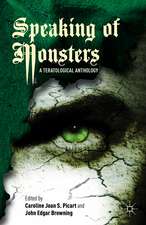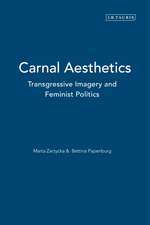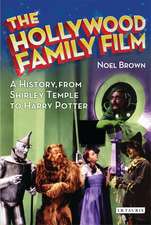The Orientation of Future Cinema: Technology, Aesthetics, Spectacle
Autor Dr. Bruce Isaacsen Limba Engleză Paperback – 22 oct 2014
Preț: 227.34 lei
Preț vechi: 259.15 lei
-12% Nou
Puncte Express: 341
Preț estimativ în valută:
43.50€ • 45.42$ • 35.92£
43.50€ • 45.42$ • 35.92£
Carte tipărită la comandă
Livrare economică 15-29 aprilie
Preluare comenzi: 021 569.72.76
Specificații
ISBN-13: 9781628924312
ISBN-10: 1628924314
Pagini: 320
Ilustrații: 25 bw illus
Dimensiuni: 152 x 229 x 23 mm
Greutate: 0.5 kg
Editura: Bloomsbury Publishing
Colecția Bloomsbury Academic
Locul publicării:New York, United States
ISBN-10: 1628924314
Pagini: 320
Ilustrații: 25 bw illus
Dimensiuni: 152 x 229 x 23 mm
Greutate: 0.5 kg
Editura: Bloomsbury Publishing
Colecția Bloomsbury Academic
Locul publicării:New York, United States
Caracteristici
A highly original approach to High Concept film analysis, which doesn't exist in film studies.
Notă biografică
Bruce Isaacs is a Lecturer in Film Studies at the University of Sydney, Australia. He has published widely on film history and theory.
Cuprins
Part 1: The Age of Late CinemaChapter 1: What is Cinema?Chapter 2: The Question of Cinema Art: The Legitimacy of Film StyleChapter 3: The Effect of the Screen- The Synthetic Narrative- The Synthetic Image Part 2: High Concept Cinema: Image, Effect, SpectacleChapter 4: Historicizing Concept Cinema: A Crisis in the ImageChapter 5: The Industrial Context of High Concept Production: Continuities and DiscontinuitiesChapter 6: Classical High Concept Aesthetics- A Case Study of Steven Spielberg and James Cameron- Incorporating Cinema: The Commoditization of the Image Part 3: Beyond Cinema: Reflections on a FutureChapter 7: New Technologies of the ImageChapter 8: The New Wave- Christopher Nolan- Michael Bay- Roland EmmerichChapter 9: Future Modalities of the Image (The Paradox of High Concept 3-D Cinema)Chapter 10: The Orientation of Future Cinema
Recenzii
The Orientation of Future Cinema offers a lucid, theoretically grounded aesthetic justification for the new media including popular 'high concept' cinema of spectacle and 3-D. Claiming that the digital image is understood as affective experience rather than representation, Bruce Isaacs takes a much-needed step toward providing a critical language for a media culture readily appreciated, manipulated and disseminated by today's generation.
The Orientation of Future Cinema is an elegantly written, provocative, richly illustrated, historically informed book that breaks new ground in cinema and media studies. Isaacs's book does much more than explore the shifting, tenuous relationship between the spectator and the image. Instead, his book actually models a fresh, surprising way of writing about the film image in an era when the idea of film itself is undergoing a revolution that opens up new possibilities for accounting for the continued lure of the film spectacle. There are so many powerful, insightful moments in the book; in fact, Isaacs's extended discussion of the complex relationship between sound and image in Francis Ford Coppola's film The Conversation or Michel Gondry's Eternal Sunshine of the Spotless Mind are worth the price of admission alone. The Orientation of Future Cinema is essential reading for anyone interested in the fate of the image in the digital era.
Film theory and criticism have often fixated on a single aspect of cinema, to the detriment of all else: space or time, movement or stillness, action or contemplation, sensuality or intellection, classical or modern, fun or philosophy . Bruce Isaac's The Orientation of Future Cinema is an attempt to keep all the paths open, to synthesize different analytical tools, and to embrace the totality of film - from art cinema to blockbusters, from yesterday's silent movies to today's digital formats. Accepting cinema equally as both an 'itinerary of the image' and a narrative art, Isaacs aims at no less than a new, integrated aesthetics of the film medium as a synthetic form, both realistic and artificial, emotive and reflective - but always, at its best, absorbing and astonishing.
The Orientation of Future Cinema is an elegantly written, provocative, richly illustrated, historically informed book that breaks new ground in cinema and media studies. Isaacs's book does much more than explore the shifting, tenuous relationship between the spectator and the image. Instead, his book actually models a fresh, surprising way of writing about the film image in an era when the idea of film itself is undergoing a revolution that opens up new possibilities for accounting for the continued lure of the film spectacle. There are so many powerful, insightful moments in the book; in fact, Isaacs's extended discussion of the complex relationship between sound and image in Francis Ford Coppola's film The Conversation or Michel Gondry's Eternal Sunshine of the Spotless Mind are worth the price of admission alone. The Orientation of Future Cinema is essential reading for anyone interested in the fate of the image in the digital era.
Film theory and criticism have often fixated on a single aspect of cinema, to the detriment of all else: space or time, movement or stillness, action or contemplation, sensuality or intellection, classical or modern, fun or philosophy . Bruce Isaac's The Orientation of Future Cinema is an attempt to keep all the paths open, to synthesize different analytical tools, and to embrace the totality of film - from art cinema to blockbusters, from yesterday's silent movies to today's digital formats. Accepting cinema equally as both an 'itinerary of the image' and a narrative art, Isaacs aims at no less than a new, integrated aesthetics of the film medium as a synthetic form, both realistic and artificial, emotive and reflective - but always, at its best, absorbing and astonishing.
Descriere
An ambitious and highly original analysis of the terrain of contemporary and future film theory, production and practice.











